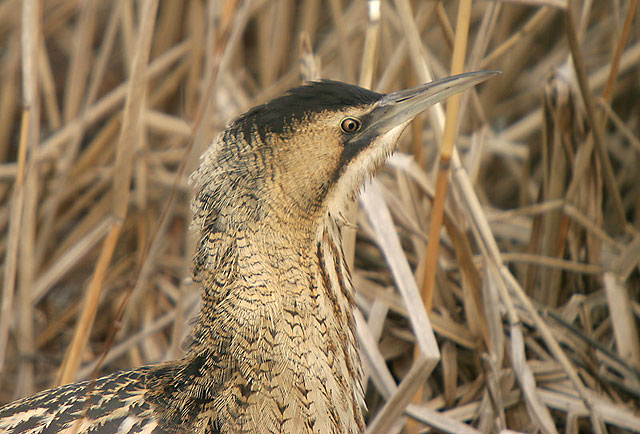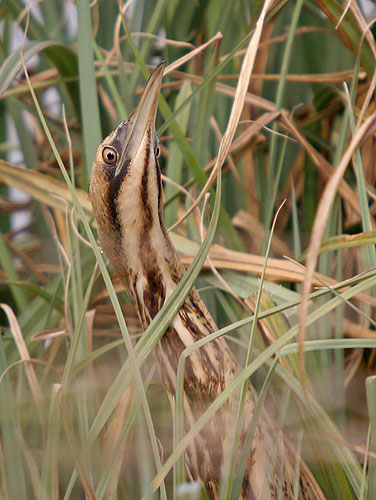
Bittern: London Wetland Centre, London The Bittern is polytypic with the nominate stellaris occurring across the Palearctic and the extralimital capensis in southern Africa. According to BWPi, capensis differs from nominate stellaris in being darker above, less strongly spotted buff, with primaries spotted rather than barred. In addition, populations of the eastern Palearctic are slightly more contrastingly striped underneath, and are sometimes considered a separate race orientalis (photo: Mark Jobling).
With 55 booming males in 2004, the Bittern is one of our rarest breeding birds. However, compared with just 11 booming males found during a UK-wide survey in 1997, this represents a dramatic turnaround in fortunes for the species. Set against a history of widespread declines in the UK, the future looks decidedly better for Bitterns at the beginning of the 21st century. Several organizations, such as the RSPB, are actively working to restore and create reedbeds, in addition to managing existing reedbeds for Bitterns, so it is to be hoped that the number of booming males continues to increase as a result. The UK BAP target is to achieve a population of not less than 100 booming males by 2020 and to increase the number of sites containing booming males to 22 by 2010.
The UK strongholds are to be found in East Anglia and around the Humber with others in Lancashire, Wales, Kent and Somerset. During the winter months numbers are swelled by the arrival of immigrants from the continent. The wintering population averages 120 birds, though in some years this may be much higher (for example, over 230 were noted during the winter period of 2002/03; see Bitterns: Winter Status 2002/03). Of course, these figures are presumably an underestimate of the actual numbers that winter in the country as many birds must pass the winter out of sight of prying optics!

Bittern: London Wetland Centre, London Bitterns tend to patiently go about their business, but when alarmed they adopt the well known 'Bittern-stance'. This involves vertically stretching the neck and body, bill pointed skywards, and eyes swivelled forwards to watch the intruder. They can retain this posture for hours, barely visible, swaying to match the movements of reeds. On such occasions they may allow quite close approach (photo: Mark Jobling).
Obtaining good views of this secretive species can be very difficult indeed. Most encounters involve a quick dash over a reedbed, or a brief foray into the open from the reeds, hardly sufficient for the observer to gorge themselves on the intricacy of the Bittern's lovely plumage. During cold weather though this normally secretive species wanders further from their reedbed 'comfort zone' in search of food, with some birds sometimes finding themselves in quite incongruous surrounds, such as the bird found at a bus stop at Stoke Newington in London! However, for the fortunate, this is one species that does occasionally 'give itself up' and at such times views can be spectacular. Mark Jobling recently sent some stunning pictures of a bird at the London Wetland Centre (Barnes WWT), London; this individual spent over an hour in front of one of the hides.

Bittern: London Wetland Centre, London According to the Migration Atlas, little is known of movements outside of the breeding season, due mainly to the secretive nature of the species. Recent studies have shown that Bitterns do disperse from natal sites. There have been no recoveries of British- or Irish-ringed birds overseas and in Britain most recoveries have been from birds fledged in East Anglia. Late-autumn sightings away from breeding areas may well be dispersing young, some of which are presumably of British origin. It's rare to see a Bittern close, and for a prolonged period of time; juveniles are similar to adults but with the black of the crown tinged brown, with the crown less extensive, usually not extending to nape. Additionally, the moustachial streak is brown rather than black. The mantle and shorter scapulars are less boldly patterned than adults, with contrast obscured by fine mottlings and vermiculations. In mid-winter, upper wing-coverts are usually paler in juveniles than adults. Immatures are apparently not separable from adults (photo: Mark Jobling).
References
Cramp and Simmons. 2004 Birds of the Western Palearctic interactive. Published by BirdGuides, Sheffield.
Wernham, C., et al. 2002. The Migration Atlas: Movements of the birds of Britain and Ireland. T and AD Poyser, London.

